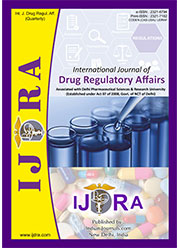RISK ANALYSIS EVALUATION OF PIROXICAM 20MG CAPSULES MANUFACTURE PROCESS BY FMEA TECHNIQUE
Abstract
This paper presents an application of FMEA (Failure Mode and Effects Analysis) on the manufacturing process of piroxicam 20mg capsules, with the objective of identifying possible failures and create subsidies for improvement of the production stages. Brainstorming or Collaborative critical analysis was used as a tool to collect information and support FMEA’s application. After the risk analysis, evaluation of the production process using FMEA, manipulation and secondary packaging were found to be the critical stages in the production process necessary for implementation of actions in order to mitigate the risks.
Downloads
References
https://www.ich.org/fileadmin/Public_Web_Site/ICH_Products/Guidelines/Quality/Q9/Step4/Q9_Guideline.pdf
2. Lewis GA, Mathieu D, Phan-Tan-Luu R. Pharmaceutical Experimental Design. New York: Marcel Dekker; 1999.
3. Moretto LD, Calixto J. Estrutura do Novo Sistema da Qualidade para a Indústria Farmacêutica. São Paulo: Sindusfarma; 2011.
4. Brasil. Law nº 8080/1990. [Internet]. Official Diary of the Union, 1990, September 19. [Cited 2018 February 01]. Available from:
http://www2.camara.leg.br/legin/fed/lei/1990/lei-8080-19-setembro-1990-365093-normaatualizada-pl.pdf
5. Brasil. Resolution of the collegiate board of ANVISA nº 17/2010. [Internet]. Official Diary of the Union, 2010 April 16. [Cited 2018 January 01]. Available from:
http://bvsms.saude.gov.br/bvs/saudelegis/anvisa/2010/res0017_16_04_2010.html
6. Brasil. Resolution of the collegiate board of ANVISA nº 60/2014. [Internet]. Official Diary of the Union, 2014 October 10. [Cited 2018 January 01]. Available from:
http://bvsms.saude.gov.br/bvs/saudelegis/anvisa/2014/rdc0060_10_10_2014.pdf
7. Brasil. Resolution of the collegiate board of ANVISA nº 200/2010. [Internet]. Official Diary of the Union, 2017 December 26. [Cited 2018 January 01]. Available from:
http://www.poderesaude.com.br/novosite/images/Publica%C3%A7%C3%A3o_3_-_28.12.2017.pdf
8. Brasil. Resolution of the collegiate board of ANVISA nº 73/2016. [Internet]. Official Diary of the Union. 2016 April 7. [Cited 2018 January 20] Available from: http://bvsms.saude.gov.br/bvs/saudelegis/anvisa/2016/rdc0073_07_04_2016.pdf
9. Kayrak-Talay D, Dale S, Wassgren C, Litster J. Quality by design for wet granulation in pharmaceutical processing: Assessing models for a priori design and scaling. Powder Technology. 2013; 240:7-18.
10. Sidor L, Lewus P. Validation & Compliance: Using Risk Analysis in Process Validation. BioPharm International. 2007; 20(2):1-7
11. Mcdermott R, Mikulak R, Beauregard M. The basics of FMEA. 2nd ed. New York: Productivity Press; 2009.
12. Mascia S, Heider PL, Zhang H, Lakerveld R, Benyahia B, Barton PI. End-to-end continuous manufacturing of pharmaceuticals: integrated synthesis, purification, and final dosage formation. Angewandte Chemie International Edition. 2013; 52:12359–12363.
13. Leeuwen JFV, Nauta MJ, Kaste D, Odekerken-Rombouts YMCF, Oldenhof MT, Vredenbregt MJ, Barends DM. Risk analysis by FMEA as an element of analytical validation. Journal of pharmaceutical and biomedical analysis. 2009; 50(5):1085-87.
14. Brunton LL, Lazo JS, Parker KL. As Bases Farmacológicas da Terapêutica de Goodman & Gilman.12nd ed. Rio de Janeiro: McGraw Hill; 2006.
15. Brasil. Farmacopeia Brasileira. 5th ed. Brasília: Agência Nacional de Vigilância Sanitária; 2010. p. 59-65.
16. Brasil. Farmacopeia Brasileira. 5th ed. Brasília: Agência Nacional de Vigilância Sanitária; 2010. p. 1204-1205
17. Yu LX, Amidon G, Khan MA, Hoag SW, Polli J, Raju GK. Understanding pharmaceutical quality by design. AAPS Journal. 2014; 16:771-83.
18. Helman H, Andery PRP. Análise de Falhas. Aplicação de FMEA e FTA. 1st ed. Belo Horizonte: Fundação Cristiano Ottoni; 1995.
19. Lachman L, Lieberman HA, Kanig JL. The theory and practice of industrial pharmacy. 3rd ed. Mumbai: Varghese Publishing House; 1987. p. 3-18.

This work is licensed under a Creative Commons Attribution-NonCommercial 4.0 International License.
The International Journal of Drug Regulatory affairs require a formal written transfer of copyright from the author(s) for each article published. We therefore ask you to complete and return this form, retaining a copy for your records. Your cooperation is essential and appreciated. Any delay will result in a delay in publication.
I/we have read and agree with the terms and conditions stated Page 2 of this agreement and I/we hereby confirm the transfer of all copyrights in and relating to the above-named manuscript, in all forms and media, now or hereafter known, to the International Journal of Drug Regulatory affairs, effective from the date stated below. I/we acknowledge that the IJDRA is relying on this agreement in publishing the above-named manuscript. However, this agreement will be null and void if the manuscript is not published in the IJDRA.
Download link for COPYRIGHT FORM







